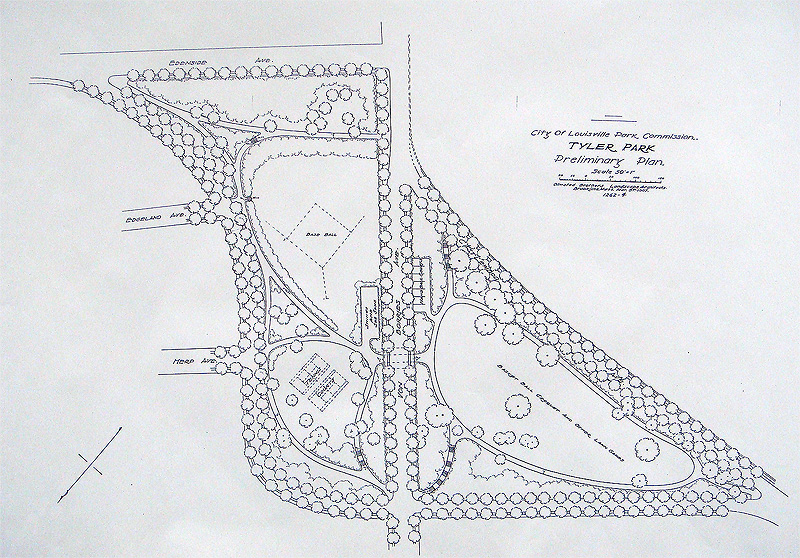Metro Parks and the Olmsted Conservancy held an information gathering session last night seeking input on Tyler Park and the Hogan Fountain area of Cherokee Park. A $50,000 master plan will be created to guide development and restoration of the parks. The plan will be carried out by a team of landscape architects, architects, and historic preservation landscape architects under the guidance of Heritage Landscapes of Vermont. The meeting attempted to discern what works, what doesn’t work, and what should be added to the parks.
Much of the discussion involved pedestrian issues such as creating a focal point at Hogan Fountain with less asphalt paving. The large “tee-pee” pavillion atop Bonnycastle Hill also occupied much of the discussion. No one would step up and say they didn’t like the shelter or that it should be removed, but the sense that it didn’t belong in an Olmsted landscape persisted. Many believed the shelter’s 50-year history in the park had earned it a place in the park. Metro Parks officials pointed out many landscape design principles that define an Olmsted park and discussed how large architectural features such as the tee-pee were generally discouraged. The building was designed by local architects Tafel & Schickli.
We believe there is ample room for improvement at both Tyler Park and Hogan Fountain, especially relating to place-making and pedestrian issues. Tyler Park, for one, could use more defined street parking and, of course, sidewalks. The tennis courts and play areas are scattered haphazardly throughout the site, so some organization would be in order, too. In a perfect world, we’d also like to see a picnic pavillion, perhaps terminating Tyler Parkway forming a grand entry into the park.
Cherokee Park’s Hogan Fountain area suffers from similar disorganization of uses and we would like to see the area immediately surrounding the fountain start to take on its own identity apart from a monument sitting in the middle of the Scenic Loop. More large trees around the “tee-pee” could also help, too. First and foremost at both locations, though, are sidewalks (especially along Cherokee Road and Castlewood Avenue). If you can’t safely walk to the park from the neighborhoods in the first place, then little else matters.
Only a plan is being generated now, and Metro Parks won’t start a project until all funds are in the bank, so this is a long term project, but improving Louisville’s Olmsted parks large and small can only be a good thing.



“The tennis courts and play areas are scattered haphazardly throughout the site” “Cherokee Park’s Hogan Fountain area suffers from similar disorganization of uses”
What? You’re not, by any chance, German are you?
Why in the world would one want an “organized” park? Tyler is a neighborhood park. The people in the neighborhood aren’t going to get lost or anything. And strangers are supposed to get lost. It’s the Olmstead philosophy, no?
Ancestry aside, there is a difference between a formal “organized” park and having modern insertions poorly placed throughout the place. We never would suggest the city “formalize” the Olmsted parks, that’s one of their greatest strengths. The play sets and splash fountains installed in recent decades, however, detract from the original plan and could be less obtrusive. That’s the disorganization of uses we’re concerned about.